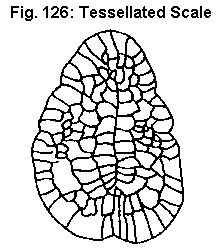
Return to: MREC Home Page
Return to: Index
DESCRIPTION
Adult Female- Living adult females are flattened, reddish brown to dark brown, and 4-5 mm in length. The body is usually somewhat oval in outline, with the anterior end angulate and the posterior broadly rounded, but the shape may change due to position on the plant. When viewed under a hand lens or magnifying glass, the dorsal surface of the body has a checkered or cellular pattern, divided by a smooth longitudinal median ridge.
Crawlers- Tessellated scale crawlers are reddish brown, flat, elongate oval, and widest in the middle area of the body.
Nymphs- Settled nymphs are light golden in color, flat, oval, and adhering so closely to the leaf surfaces as to be nearly transparent. Males are unknown.
Fig. 126: Tessellated Scale, Eucalymnatus tessellatus
(Signoret). Coccidae, HOMOPTERA 
BIOLOGY
Distribution- Tessellated scale is a tropical species whose original home was probably South America. It has been disseminated by man to all parts of the world on its cultivated hosts. Tessellated scale occurs out-of-doors in Florida, California and most tropical areas, and in greenhouses throughout the world.
Host Plants- Tessellated scale occurs most commonly on palms and several species of Ficus, but it has been found on a wide variety of host plants.
Damage- Tesselated scale is primarily a leaf-infesting soft scale and a greenhouse pest. Heavy infestations weaken the plant but seldom kill it. Infestations are often of economic importance in commercial nurseries whenever pest management programs are neglected.
Life History- One or two generations per year, and in greenhouses generations will overlap. Tessellated scale is parthenogenetic and ovoviviparous, giving birth to living young. Males are unknown.
CONTROL
The parasitic wasp, Metaphycus stanleyi Compere is a natural enemy of tessellated scale. As with other scale insects, tessellated scale is best controlled in the immature stage. For specific chemical control recommendations, see the current Cooperative Extension publications on ornamental plant pest management or consult your county agent.
University of Florida/IFAS Reference to Pest Control Guides